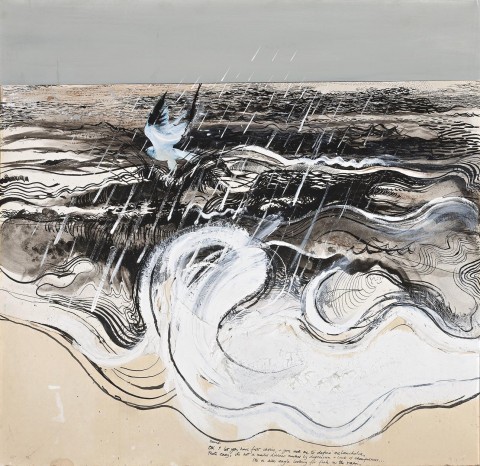MELANCHOLY, 1970
BRETT WHITELEY
oil and mixed media on card on board
72.5 x 75.5 cm
inscribed centre lower right: David. OK I let you have first choice, & you ask me to define melancholia. / Thats [sic] easy, its [sic] not a mental disease marked by depression & lack of cheerfulness… / Its [sic] a sea eagle looking for fish in the rain.
signed and dated verso: Brett Whiteley 1970
Australian Galleries, Melbourne
Barry Stern, Sydney, acquired from the above in 1977
Private collection, London, acquired from the above c.1977
Sutherland, K., Brett Whiteley: Catalogue Raisonné: 1955-1992 [in press], Schwartz Publishing, Melbourne, 2019, cat. no. 91.70
We are grateful to Kathie Sutherland for her assistance in cataloguing this work.
And then she said, “Please produce something beautiful and simple, so we don't have to think too much”, and I said “Yes, it's time for purity. Do you have a theme?” She turned and tinglingly said, “Yes, The Sea”’.1
When Brett Whiteley's muse thus suggested the sea as a new theme, both appreciated the need for him to restore and recharge his creative soul after the grueling production of his monumental Alchemy, 1973 earlier that year. Demanding a total turning inward 'to steal the Fire’2, the frenetic surrealist eruptions characterising the Alchemy series had encompassed a myriad of sources and influences to present across eighteen panels an autobiographical journey of gigantic ambition – a birth-to-death vision of the artist. Now, turning his attention outward to the gentler subject of nature, and specifically waves, Whiteley found a motif which was not only visually satisfying, but emotionally and intellectually less draining. Diametrically opposed in their absence of artifice or angst, thus Whiteley’s wave compositions offered a peaceful antidote to his darker, more labored musings – tangibly embodying the complex Rimbaudian duality that so distinguishes his oeuvre. As Sandra McGrath elucidates, ‘… in truth he was living out one of his constant themes – good and evil, optimism and pessimism, New York and Fiji, Christie and the London Zoo series … all meshed into one overall psychological and pictorial design, one lifelong attempt to reconcile extremes, one eternal battle to identify the truth that E.M. Forster recognised as being accessible only by experiencing opposites’.3
Painted three years earlier, the magnificent Melancholy, 1970 represents an important prelude to the Waves series of nine oils and seven large drawings that was unveiled at Australian Galleries in 1973. In the surging cacophony of linear swirls here one may already discern the genesis of such masterpieces as Thebe’s Revenge, 1973, with the calligraphic line not only revealing the artist's formidable talent as a draughtsman but moreover, referencing his abiding interest in Asian art and paying homage in particular to Hokusai’s celebrated ‘Wave’. Similarly, there exist poignant allusions to his artistic and spiritual mentor Vincent van Gogh, in whose work the young Antipodean perceived ‘… a heightening of reality, in that everything I looked at took on an intensity – an expandingness'.4 The inclusion of the sea eagle also invites comparison with Whiteley’s own lyrical depictions of the bird kingdom –especially those inspired by his recent travels to Fiji, such as The Pink Heron, 1969 – where the flight-filled creature serves unequivocally as a metaphor for freedom, both of body and spirit, ‘… the idea of extraordinary escapism, a world external from the quagmire’.5
That Melancholy is imbued with such connotations of optimism and hope despite its ostensibly gloomy title would also seem to accord with the artist’s detailed inscription, most probably directed to his friend and philosophical sparring partner at the time, David Litvinoff: ‘… you ask me to define melancholia. That’s easy, it’s not a mental disease marked by depression and lack of cheerfulness … It’s a sea eagle looking for fish in the rain’. Exuding elegance and inspired simplicity, the painting evokes brilliantly the kind of intense, meditative response that Whiteley had so admired not only in the work of Van Gogh, but in the prose of French modernist poet Baudelaire; as specifically cited in the catalogue accompanying his Waves exhibition.
‘O Man, so long as you are free you will cherish the sea / The sea is our looking-glass; you contemplate / Your own soul in the infinite unfolding of its waves, / While your mind is no less a bitter gulf’.6
1. Whiteley, B., 'Introduction' in Waves, exhibition catalogue, Australian Galleries, Melbourne, June 1973, unpaginated
2. McGrath, S., Brett Whiteley, Bay Books, Sydney, 1979, p. 152
3. ibid., p. 94
4. Whiteley cited in Waves, op. cit., unpaginated
5. McGrath, op. cit., p. 94
6. Baudelaire cited in Waves, op. cit., unpaginated
VERONICA ANGELATOS
